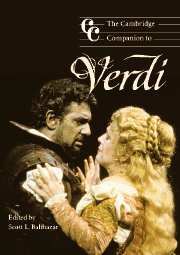Book contents
- Frontmatter
- Part I Personal, cultural, and political context
- Part II The style of Verdi's operas and non-operatic works
- 4 The forms of set pieces
- 5 Newcurrents in the libretto
- 6 Words and music
- 7 French influences
- 8 Structural coherence
- 9 Instrumental music in Verdi's operas
- 10 Verdi's non-operatic works
- Part III Representative operas
- Part IV Creation and critical reception
- Notes
- List of Verdi's works
- Select bibliography and works cited
- Index
10 - Verdi's non-operatic works
from Part II - The style of Verdi's operas and non-operatic works
Published online by Cambridge University Press: 28 September 2011
- Frontmatter
- Part I Personal, cultural, and political context
- Part II The style of Verdi's operas and non-operatic works
- 4 The forms of set pieces
- 5 Newcurrents in the libretto
- 6 Words and music
- 7 French influences
- 8 Structural coherence
- 9 Instrumental music in Verdi's operas
- 10 Verdi's non-operatic works
- Part III Representative operas
- Part IV Creation and critical reception
- Notes
- List of Verdi's works
- Select bibliography and works cited
- Index
Summary
Though primarily an opera composer, Verdi also wrote a number of works in other genres. Only one of these, the Messa da Requiem, has assumed a significant place in the repertory. The remaining solo songs, instrumental music, and choral works, more-or-less ignored and virtually forgotten, are infrequently performed and have not been broadly discussed in print. Consequently, this chapter will provide an overview of their history, style, and sources.
Beginning as a young boy in Busseto, Verdi composed a variety of non-operatic works, both sacred and secular. In mid-career he attested to the diversity of his youthful compositional activities:
From the age of thirteen to the age of eighteen (the time when I went to study counterpoint in Milan) I wrote a hodgepodge of pieces: hundreds of marches for band, perhaps just as many small sinfonie that were played in church, in the theatre, and at concerts; five or six concertos and variations for piano, which I myself played in concerts; several serenades, cantatas (arias, a lot of duets, trios), and diverse pieces for church, of which I remember only a Stabat mater. In the three years I was in Milan I wrote very few free compositions: two sinfonie which were performed in a private concert in the Contrada degli Orefici though I do not remember in whose house, a cantata which was performed at the home of Count Renato Borromeo, and a variety of pieces, most of them comic ones, which the maestro [Lavigna] had me write as exercises and which were not even orchestrated. After returning to my hometown I began to write marches, sinfonie, vocal pieces, etc., an entire Mass and an entire Vesper service, three or four Tantum ergo and other sacred pieces that I do not remember. Among the vocal pieces there were three-voice choruses from Manzoni’s tragedies, and Il cinque maggio for solo voice. Everything is lost, and that is just as well, with the exception of a few sinfonie that they still play here [Busseto], but which I never again wish to hear, and the Inni di Manzoni which I have kept.
- Type
- Chapter
- Information
- The Cambridge Companion to Verdi , pp. 169 - 182Publisher: Cambridge University PressPrint publication year: 2004



